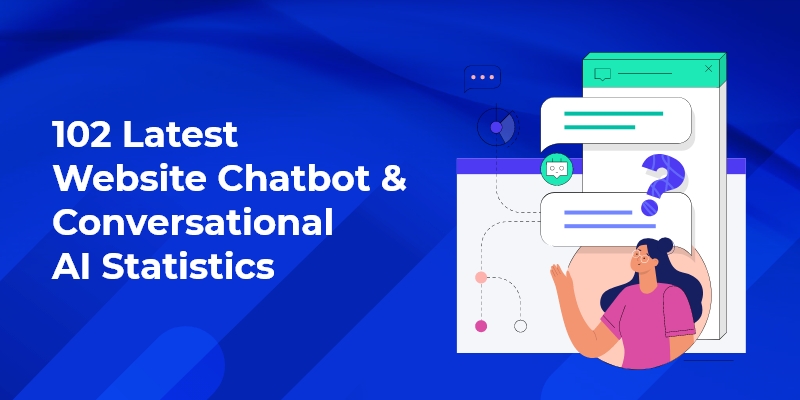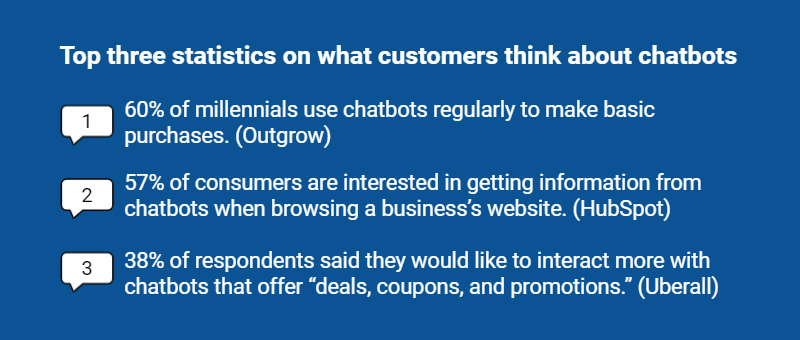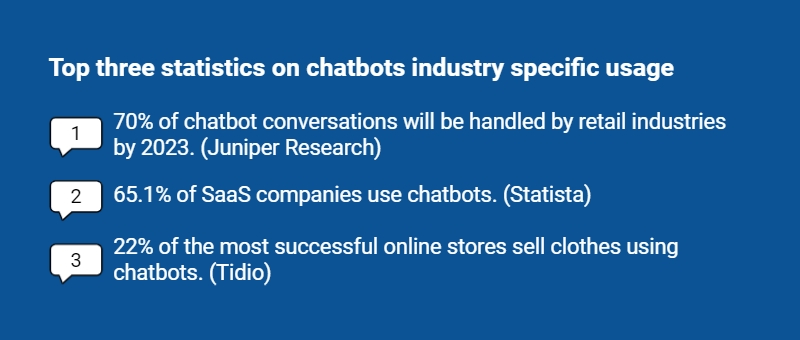102 Latest Website Chatbot & Conversational AI Statistics

Table Of Contents:
As long as people like to chat and converse with each other, chatbots are here to stay.
So, we bring you up-to-date statistics on chatbots and conversational AI to help you understand its market size, scope, adoption, usage, product planning, and decision-making process.
Before getting started, let’s understand that chatbots are one of the principal applications of conversational AI.
Conversational AI refers to technologies, like chatbots or virtual agents, which users can talk to. They use large volumes of data, machine learning, and natural language processing to help imitate human interactions, recognizing speech and text inputs, and translating their meanings across various languages. (IBM)
I. Stats on Chatbot Market Size and Trends
Chatbot market size is growing at an exponential pace. More and more companies are interested in adopting it on their website and social media platforms because it enables them to communicate with their customers instantly. Below are few statistics to help you understand it.
1. 1.3 billion USD is the expected growth of the chatbot market size by 2025 with a compound annual growth rate of 29.7%. (Cognizant)
2. 500 times increase is seen in the interest toward chatbots in the last 5 years. (Google Trends)
3. 112% is the projected value of chatbot E-commerce transactions by 2023. (Juniper Research)
4. 96% of businesses believe chatbots are here to stay. (Mindbrowser)
5. 90% of businesses that use chatbots for customer support seen just a $0.70 cost per interaction and saved up to 4 minutes per enquiry. (Juniper Research)

6. 90% of companies are planning to deploy AI within 3 years and this number is expected to grow to 40% by 2023. (Gartner)
7. 70% of white-collar workers will engage with chatbots every day by 2022. (Gartner)
8. 60% of businesses say chatbots improve the ability to handle clients. (Accenture)
9. 57% of CIOs and CTOs around the world agree that conversational chatbots can deliver large returns on investment for minimum effort. (Accenture)
10. 56% of CIOs and CTOs say conversational bots are driving disruption in their industry, and 43 percent report their competitors are already implementing the technology. (Accenture)
11. 50%+ of companies such as Google, IBM, and Facebook are investing more money on chatbots every year than building mobile apps. (Gartner)
12. 50% of businesses don’t use chatbots because they don’t know how to. (Tidio)
13. 30% savings in operational costs is witnessed by companies using chatbots. (IBM)
14. 28% of leading companies use AI for marketing. (Adobe)
15. 23% of US websites have chatbots and it is also the country that has the highest chatbots/1000 people rate. (Boomtown)
16. 20 million US dollars is saved by businesses using chatbots globally. (Juniper Research)
17. 5 top countries that are using chatbots are the USA, India, Australia, UK, and Canada. (Boomtown)
18. 1 in 6 global customer service interactions is handled by AI in 2021. (Gartner)
II. Stats on Chatbot Sales and Conversion
Since chatbots enable companies to communicate with their customers instantly and 24/7, it provides immense conversion opportunities using strategies like personalized product recommendations, promoting offers, sales, or events, recover abandoned carts, and book meetings with sales reps for a demo, RFQs, and so on. The below statistics with help you to understand it further.
19. 6.1 billion USD is spent by B2B companies in 2019 to drive traffic to websites, yet only 1-2% of traffic converted into leads. (US B2B Digital Ad Spending – eMarketer)
20. 97% of first-time visitors to e-commerce websites leave without making a purchase. (Woocommerce)
21. 70% loss in sales is witnessed by companies due to cart and checkout abandonment. (Baymard)
22. 70% reduced call, chat, and email inquiries are witnessed by organizations using virtual customer assistants. (Gartner)
23. 77% of companies are using chatbots for after-sales and customer support. (Accenture)
24. 68.9% of chats can be handled by chatbots from start to finish. (Comm100)
25. 68% of respondents believe that instant messaging will improve the user experience. (Facebook IQ)

26. 68% of B2B professionals believe that increasing the number of quality leads is a top priority something that chatbots are good at. (B2B Technology Marketing Community)
27. 67% average sales increase was witnessed by business leaders using chatbots. (Forbes)
28. 64% of companies feel chatbots provide a more personalized service experience for their customers. (Statista)
29. 57% of businesses claim that chatbot delivers a big ROI on minimal investment. (Accenture)
30. 55% of businesses that use chatbots regularly have generated high-quality leads. (Drift)
31. 52% of consumers are more likely to make repeat purchases if the company offers support via live chat. (Kayako)
32. 52% of companies use chatbots to welcome their visitors, 31% use them to deal with answering FAQ questions, and 29% use chatbots to generate leads. (Tidio)
33. 48% of consumers spend more when their experience is personalized. (Janrain)
34. 47% of respondents are willing to buy e-commerce products using chatbots as they can provide personalized product recommendations. (HubSpot)
35. 42 hours is the average time for B2B companies to respond to a lead after they’ve filled out a form (Harvard Business Review). Connecting with leads within 5 minutes see a 9x higher chance of conversion something that they can do with conversational AI chatbots.
36. 42% of revenue is generated from browse abandonment campaigns (Mailchimp) something that you can do with chatbots while the visitors are still on the site.
37. 41.3% of consumers said they used chatbots for purchases in 2020. (Drift)
38. 40% of companies have implemented chatbots to do sales and marketing activities. (Accenture)
39. 39% of businesses use chatbots to make their websites more interactive. (Tidio)
40. 39% of purchasers are influenced by a relevant search. (Think with Google)
41. 35% of revenue is seen by companies using upselling and cross-selling activities (Amazon) something that website chatbots can do better.
42. 33% of users prefer to use chatbots to make reservations, order online, and more. (Drift)
43. 30% better ROI is provided via Facebook Messenger than retargeting ads. (Business Insider)
44. 41.3% of consumers expressed their willingness to use chatbots for purchases in 2020 which was only 17.1% in 2019. (Drift)
45. 7-25% revenue increase is witnessed by e-commerce companies using abandoned cart chatbots. (Tidio)
46. <5% is the re-engagement conversion rate when a visitor closes the browser so it is always better to engage users effectively to convert while they are on the website. (Statista)
47. 4 min 17 sec is the average queue waiting time and chatbots could help to shorten it. (LiveChat)
Here’s Your Golden Key To E-Commerce Growth: Discover The 12 Big Ways Conversational Chatbots Boost eCommerce Sales.
III. Stats on Chatbot Customer Preferences
Chatbots are built to enhance customer engagement, customer experience, and customer satisfaction. Here are the statistics to help you understand whether chatbots delivers it or not. Mostly importantly, you will understand what your customers actually want or expect from them.
48. 1.4 billion people using messaging apps and are willing to talk to chatbots. (Acquire)
49. 87.58% is the average customer satisfaction rate of chatbots. (Comm100)
50. 87.2% of consumers rate their typical chatbot experience as within the range of neutral to positive. (Drift)
51. 83% of consumers said they would be more loyal to a brand that offers a chatbot for tasks like making an appointment or handling customer service inquiries. (Mobile Marketer)
52. 80% of customers state that had a positive experience with chatbots. (Uberall)
53. 80-90% response rate is seen in well-designed chatbots while 35-40% response rate is seen in low-end bots. (Matthew Barby)
54. 74% of people hate being shown irrelevant content. (Janrain)
55. 73% of B2B buyers say they want a personalized, B2C-like customer experience. (Accenture)

56. 71% of customers expect companies to communicate with them in real-time. (Salesforce)
57. 69% of customers like using chatbots because of how quickly they can get in touch with a company. (Salesforce)
58. 67% of customers prefer self-service over speaking to a company representative. (Zendesk)
59. 66% of customers are willing to share personal information with companies–but only in exchange for some perceived value. (Accenture)
60. 41% of online chat conversations with businesses are initiated by C-level executives. (Drift)
61. 60% of millennials use chatbots regularly to make basic purchases. (Outgrow)
62. 64% of internet users said 24-hour service is the best feature of chatbots. (Outgrow)
63. 64% of businesses believe that chatbots will allow them to provide a more customized support experience for their customers. (Statista)
64. 63% of people don’t realize they’re already using AI technologies. (HubSpot)
65. 57% of consumers are interested in getting information from chatbots when browsing a business’s website. (HubSpot)
66. 56% of customers expect to find what they’re looking for from a company in 3 clicks or less (Salesforce) something that they can do with chatbots.
67. 55% of people who use chatbots would expect them to provide instant responses and answers to simple questions. (Drift)
68. 55% of consumers feel that they will try a chatbot that offers location-based deals. (Uberall)
69. 50% of customers expect a business to be available 24/7. (VentureBeat)
70. 50% of consumers say that the main reason they cannot resolve an issue on their own is that there is too little information online. (Microsoft)
71. 49% of respondents say that compared to the more traditional channels, messaging businesses offer them more truthful responses. (Facebook IQ)
72. 49% of buyers have made impulse purchases after receiving a more personalized experience. (Intrado)
73. 48% of customers care more about chatbots solving their issues rather than it having a personality. (Business Insider)
74. 46% of companies leveraging intelligent assistants or AI chatbots use them for voice-to-text dictation. (Spiceworks)
75. 40% of millennials claim to engage with bots on a daily basis. (Mobile Marketer)
76. 38% of respondents said they would like to interact more with chatbots that offer “deals, coupons, and promotions.” (Uberall)
77. 37% of respondents rated getting a quick answer in an emergency as the number one use case for a chatbot. (Audience & SalesForce)
78. 35% of consumers want to see more companies using chatbots. (Opus Research)
79. 35% of people use chatbots to resolve a complaint or problem, or for getting detailed answers. (Drift)
80. 34% of retail customers said they would be comfortable speaking with an chatbot instead of a live customer support representative. (Statista)
81. 30% of US consumers rate chatbot interactions as “very effective” in dealing with customer service issues. (Microsoft)
82. 30% of consumers say that not being able to reach a real human is the most frustrating part of a bad customer service experience. (Microsoft)
83. 27% of consumers are interested in artificial intelligence support tools. (Tidio)
84. 27% of consumers were unsure if the last customer support interaction they had was with a real person or a chatbot. (PwC)
85. 22% of respondents say that trust chatbot recommendations for product purchases. (Cognizant)
86. 10 seconds is the time you have on your website to capture a lead’s attention (Nielsen Norman Group) something that you can do with chatbots.
87. 9 out of 10 consumers would like the option to use messaging to contact a business. (Twilio)
88. 9% of the consumers only think that companies should never use chatbots. (Userlike)
Read this Insight Article to Make Best Use of Chatbots: How to Create a Conversion-Focused Buyer Journey with Chatbots.
IV. Stats on Chatbot Industry Specific Usage
How do chatbots help different industries and use-cases? Take a dive into the following statistics and understand how different industries are putting chatbots into action.
89. 90% of bank transactions are expected to be automated by chatbots in 2022. (Chatbots Magazine)
90. 80% of entrepreneurs are expected to adopt chatbots. (Chatbots Magazine)
91. 70% of chatbot conversations will be handled by retail industries by 2023. (Juniper Research)

92. 65.1% of SaaS companies use chatbots. (Statista)
93. 64% of informational bots are used in the health sector whereas 59% of such bots are used in the IT and communications industries. (Accenture)
94. 53% of companies identify AI as a tool for creating a ‘customer-first culture’ (CX Network)
95. 58% of B2B companies and 42% of B2C companies use a chatbot on their websites. (Relay)
96. 28% of real estate businesses now use chatbots followed by travel (16%), education (14%), healthcare (10%), and finance (5%). (Chatbot Life’s 2019 report)
97. 22% of the most successful online stores sell clothes using chatbots. (Tidio)
V. Stats on Chatbot Limitations
Can chatbots do everything for you? Here are few statistics that highlight its limitations and areas of improvement. Brands should try to build the right chatbot that delivers a best-in-class experience.
98. 60% of executives said their organization simply doesn’t have the skills to develop and deploy conversational bots in-house and that’s the major reason to collaborate with external vendors. (Accenture)
99. 43% of respondents said chatbots need to work on their accuracy in understanding what customers are asking or looking for. (Uberall)

100. 25% stated that the high cost of chatbots and intellectual AI assistants keeps them from the initial implementation. (Accenture)
101. 23% of consumers still prefer to have face-to-face interaction for complex issues. (American Express)
102. ‘The lack of understanding’ and the ‘inability to solve complex issues’ are consumers’ biggest chatbot concerns. (NewVoiceMedia)
VI. Closing Thoughts
All the above-stated statistics clearly indicate that chatbots are here to stay. As the market grows, rule-based chatbots will no longer be adopted and more intelligent conversational AI chatbot platforms will start to rule.
Customer expectations will keep evolving. With the growing complexity of the market, brands that offer real-time personalized experiences will grow faster and conversational chatbots help you to achieve it with ease.
We built RoundView conversational AI chatbot with one primary goal – to make your website have better conversations with your customers and increase the conversion rate by serving them first-class.
Schedule a demo with us today and discover the RoundView chatbot’s immense capabilities.



